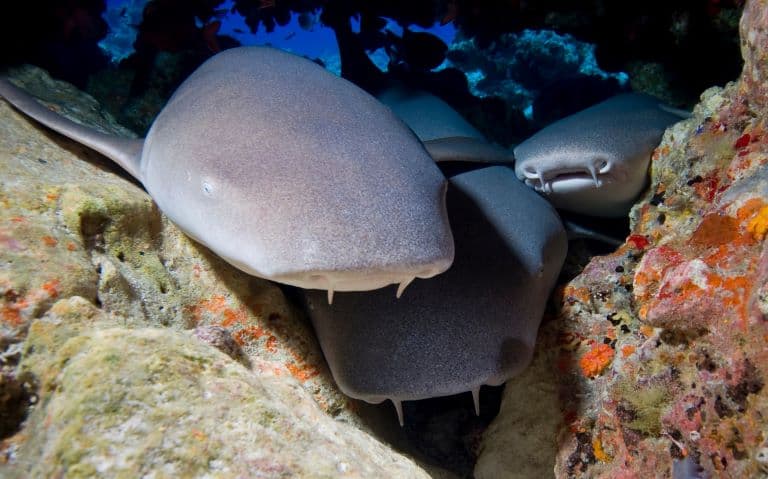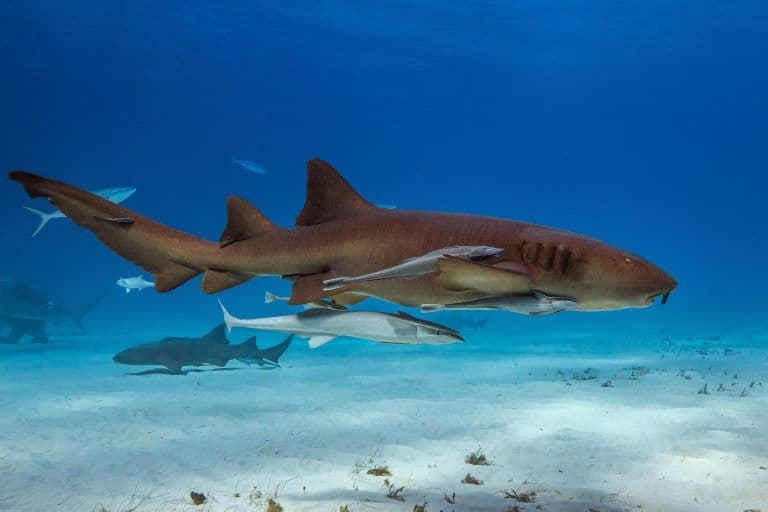Nurse Shark Profile
With Latin being historically used to censor information from the lower classes, it’s right to be suspicious of it, but when it comes to naming animals, it comes in very handy.
Much as you might be disappointed travelling all the way to the Scottish coast to discover your Tinder match was an underwhelming Gulosus, you might also be surprised when trying to get rid of all your weasels, you fall into the ancient trap of befriending a Mustela nivalis.
Equally, should you ever find yourself in a hospital with a nurse shark taking blood samples, you may rightfully decry the common naming systems of animals and start to appreciate why we have Latin names for things in the first place.

Nurse Shark Facts Overview
| Habitat: | Warm, shallow marine |
| Location: | West Atlantic, East Pacific |
| Lifespan: | Around 25 years in captivity |
| Size: | 430cm (14 ft) long |
| Weight: | 114kg (250 lb) |
| Colour: | Shark grey |
| Diet: | Small fish, rays, crustaceans, shellfish |
| Predators: | Alligators, larger sharks |
| Top Speed: | Slow |
| No. of Species: | 1 |
| Conservation Status: | Vulnerable (ICUN) |
Nurse sharks never claimed to be medical professionals, so it’s a bit unfair to rag on them for it. And these large sharks have a lot of other things to boast about. They’re whiskered dancers, specialising in sucking food up from the sand, and well adapted to being generally lazy, peace-loving fish.
Unfortunately, like most sharks, they’re in decline from being dragged out of the water both by mistake and on purpose.
Interesting Nurse Shark Facts
1. They have a terrible bedside manner
Nurse sharks are big. At over four meters long, they can certainly handle themselves against most animals in the ocean, especially if those animals are better suited to life on land.
While they’re not aggressive at all and prefer to be left alone, a shark this big has a lot of muscle and a lot of teeth, and if you start poking around a live one, you may well find that out the painful way.
Their name doesn’t come from their skills in inserting catheters – they’re actually quite bad at this – but the origins aren’t fully established.
Either the name stems from the word hurse, an Old English word for sea floor, or it comes from the resemblance of their feeding habits to a nursing baby. But this is not an animal you would want hanging off your nipple. 1

2. They suck bottom
But you wouldn’t want them hanging off of that, either. These sharks eat crabs and lobsters molluscs and so on, as well as rays and fish and other softer prey. They get all this from the sea floor, which they suck up and set upon using several rows of teeth, each containing around 70 such teeth, all sharp and stabby.
They have such strong sucking abilities they’ve been said to be able to pull a conch out of its shell. 2
3. They’re very sedentary
Such is the variety of their diet, they don’t need to venture far for food. In fact, these are some of the laziest sharks in the ocean.
Even among reef sharks, they are very sedentary, preferring to stay put, and even returning to the same breeding grounds, time after time.
4. Because they’re unfit
Or, perhaps, this is the other way around. Evolution is all about jettisoning deadweight, and good stamina is a waste of resources in a couch potato like the nurse shark.
When the physiological response to exercise in nurse sharks was measured, it was found that moving around is actually very costly for the shark – around twice that of some obligate swimmers that need to move in order to breathe.
This means they’re really not set out for the long hours of standing up and moving around that’s typical of the nursing profession. 3

5. But they can dance
That’s not to say they can’t move at all, and across the animal kingdom, if there’s one thing that motivates a creature to get off the sofa, it’s sex.
Nurse shark copulation rituals are an elegant mix of motion and sexy nibbling. Some of these include parallel swimming, “pivot and roll”, nudging, and pectoral biting, many of which can also be found in the Kama Sutra.
If this isn’t exhausting enough for an out-of-shape fish, females will often do it with multiple males. 4

6. They can have several fathers
Females take around 18 months to make a batch of eggs, but when they do, there are multiple of them, which means multiple sperm can fertilise them.
As a result, mating with several males creates a litter of half-brothers and sisters, fathered by more than one male.
There can be up to around 30 pups in a litter, and they’re all born live, after being gestated inside the mother for about six months.
This helps spread genetic diversity, even within single litters.
7. Threats
As usual, the Nurse shark is in great danger from overfishing. As part of the more than one hundred million sharks killed each year, their numbers are dropping, and they’re picked up as by-catch in a number of different fishing gear.
Trawls, beach seines, gillnets, longlines, and others all tag this species, and they’re also hunted on purpose by spearfishers and as collections for aquariums.
Climate change and pollution are damaging the reefs these fish rely on, reducing their available options, a the species is now listed as Vulnerable, at risk of further declines. 5

Nurse Shark Fact-File Summary
Scientific Classification
| Kingdom: | Animalia |
| Phylum: | Chordata |
| Class: | Chondrichthyes |
| Order: | Orectolobiformes |
| Family: | Ginglymostomatidae |
| Genus: | Ginglymostoma |
| Species: | cirratum |
Fact Sources & References
- “Nurse Shark”, South Carolina Aquarium.
- “Nurse Shark”, Sharkwater Extinction.
- Nicholas M. Whitney (2016), “The effects of temperature and swimming speed on the metabolic rate of the nurse shark (Ginglymostoma cirratum, Bonaterre)”, Science Direct.
- A. Peter Klimley (2015), “American Society of Ichthyologists and Herpetologists (ASIH)”, Sci Hub.
- “Atlantic Nurse Shark”, IUCN Red List.
